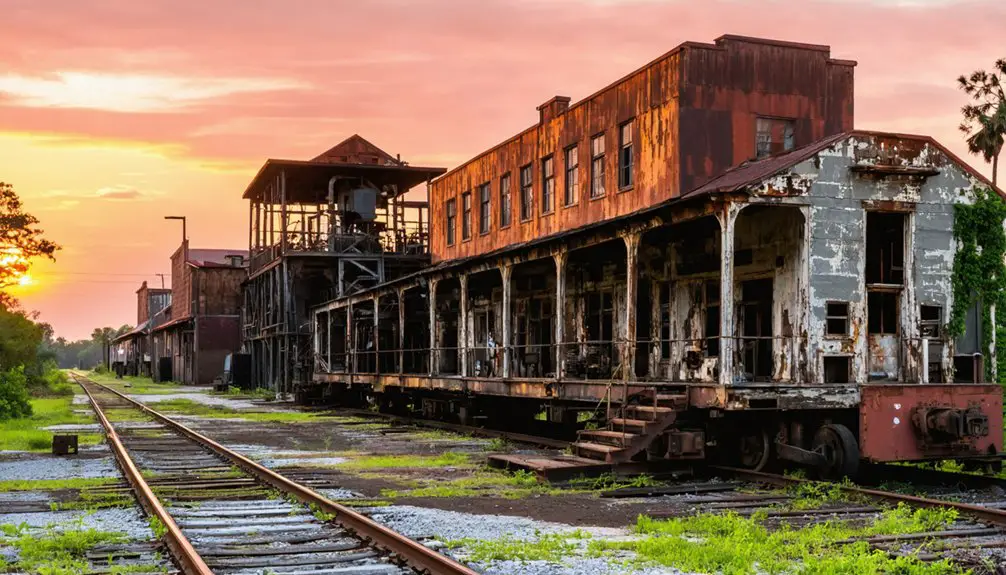You’ll find Brewster, Florida tucked away one mile east of State Road 37, where American Cyanamid built this company town in 1910 to support phosphate mining operations. At its peak, 2,500 residents called Brewster home, living in 163 company houses near the iconic Brewster Power Plant. The town operated until 1962, when American Cyanamid closed operations and offered homes to residents at bargain prices. Today, nature has reclaimed much of this ghost town’s industrial remnants, though its rich history still beckons visitors.
Key Takeaways
- Brewster was a phosphate mining company town founded in 1910 by American Cyanamid, reaching a peak population of 2,500 residents.
- The town closed in 1962 when American Cyanamid ceased operations, offering residents the chance to purchase their company homes.
- Industrial ruins, including the iconic power plant smokestack, remain as visible remnants of this abandoned mining community.
- The town’s layout reflected racial segregation, with separate residential areas and facilities for white and Black workers.
- Nature has reclaimed most structures, making Brewster a true ghost town, though preservation efforts continue through museum exhibits and tours.
The Birth of a Company Town
In 1910, American Cyanamid established the company town of Brewster to support its phosphate mining operations in central Florida. Located a mile east of what’s now State Road 37, the town emerged along a crucial railroad line that would serve both industrial and community needs.
You’ll find that company ownership defined every aspect of Brewster’s creation. The first major development was the Brewster Power Plant with its distinctive smokestack, providing essential energy for both mining operations and the growing community. Racial segregation shaped the town’s layout, with white residents living south of the mine and black residents to the east.
As the mining facilities expanded with washing and drying installations, the town grew simultaneously to house workers who’d otherwise face hours of travel to the nearest city. At its peak, Brewster boasted 163 company houses and supported a population of roughly 2,500 residents. The town provided essential amenities including a school and grocery store, making it a self-sufficient community.
Life in Brewster’s Mining Community
If you’d lived in Brewster during its heyday, you’d have worked alongside 2,500 residents in the phosphate mines, where your daily schedule revolved around mining shifts and company operations.
After work, you could’ve enjoyed the town’s social spots like the saloon or participated in community activities, all while living in one of 163 company-owned houses provided to employees.
Your housing came with strict company oversight, including early morning inspections of housekeeping standards, and you’d have to relocate upon retirement as part of American Cyanamid’s company town policies. Children often played freely as doors were unlocked in this tight-knit community.
The town thrived until 1962’s official closure forced residents to either purchase their homes or watch them be demolished.
Daily Work and Wages
Life in Brewster revolved around the demanding work at American Cyanamid Company’s phosphate mining operations, where employees worked long daylight shifts performing physically intense tasks.
You’d start your day early, operating heavy machinery, extracting phosphate, or working in the processing plants under strict company oversight and scheduling.
The wage disparities were evident in this company town, where your pay depended on your role but generally remained modest by industry standards.
While your wages might’ve been your family’s only income source, the company offset low pay by providing housing and basic amenities.
You’d face daily inspections of your company-owned home, and your employment status determined whether you could stay in town, reflecting the challenging labor conditions of the era.
Social Activities After Hours
While working hours dominated much of daily existence, Brewster’s social life blossomed during evening gatherings and weekend activities. You’d find neighbors hosting barbeques and organizing afternoon card parties, creating a tight-knit atmosphere where everyone knew each other’s names.
The local movie theater and public swimming pool offered entertainment, while schools served as community hubs for family events. Today, only the remnants of these gathering spots remain, with the old power plant smokestack standing as a silent reminder of Brewster’s vibrant past. The area now joins over 150,000 acres managed by reclamation teams who oversee the land’s transformation.
However, you couldn’t ignore the town’s stark racial segregation, with white residents living south of the mine and black residents to the east. Each section maintained its own social networks and spaces.
For teenagers, the lack of nightlife led to significant teenage isolation, as evening gatherings centered mainly on family-oriented activities. The mining company’s control over social life meant limited options for those seeking more diverse entertainment.
Company Housing and Benefits
The company-owned homes of Brewster emerged in 1910 when American Cyanamid established this remote mining town to house its phosphate workers. You’d find modern one- and two-story homes equipped with indoor plumbing, bathrooms, and garden spaces, though the community’s layout reflected the era’s segregation between white and black workers’ quarters.
While the housing system demonstrated community resilience by providing essential amenities like medical care, schools, and recreation facilities, it also created economic dependency. You couldn’t own your home while working there, and you’d have to vacate upon retirement or leaving your job. The town’s amenities included a drug store and doctor to serve the mining community’s healthcare needs.
When Brewster finally closed in 1962, the company offered residents a chance to purchase their homes at minimal prices before demolition, helping families shift to nearby towns like Fort Meade and Bartow.
Architecture and Urban Planning
Established in 1910 as a company town by American Cyanamid, Brewster’s architectural layout reflected both its industrial purpose and the social dynamics of the era.
You’ll find the town was carefully zoned with segregated residential areas – white residents lived south of the mine, while black residents were housed to the east.
The town’s design centered around its industrial heart, with the power plant smokestack dominating the skyline. The area contains some of the richest phosphate deposits in Florida.
You can still trace the original street grid and building plots from aerial views, though most structures have succumbed to urban decay.
The town’s abandoned architecture tells a story of self-sufficiency, featuring everything from schools and stores to a swimming pool and movie theater.
After closure in the 1960s, residents relocated many homes to nearby towns, leaving behind only scattered remnants of Brewster’s once-bustling infrastructure.
Social Structure and Segregation
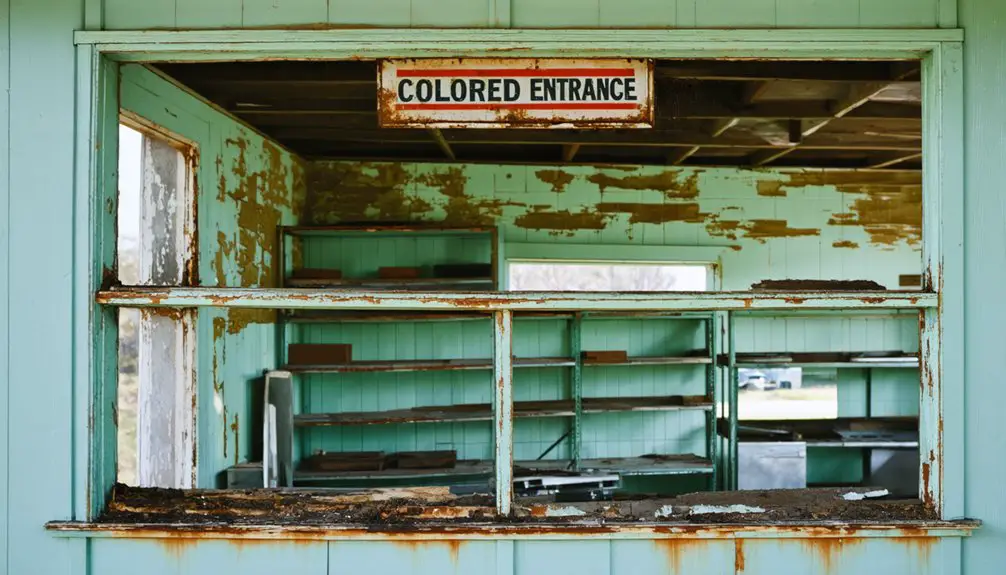
If you’d visited Brewster during its operational years, you’d have encountered a town strictly divided by race, with white residents living south of the mine while Black residents were restricted to the eastern section.
You’d have witnessed how this physical separation extended into every aspect of daily life, from segregated schools and medical facilities to separate social spaces and amenities like the theater and swimming pool.
Through these enforced divisions, white residents maintained social and economic power over the Black community, though Black residents established their own cultural institutions and developed a distinct community identity within these constraints. The town’s infrastructure and amenities were built by the American Cyanamid Company to serve its phosphate mining operations until the town’s closure. This system of segregation persisted until the Civil Rights Act 1964 finally led to the desegregation of Jacksonville’s hospitals and other facilities.
Divided Living Spaces
While federal policies and social practices enforced racial segregation across America, Brewster’s living spaces reflected this broader pattern of systematic division.
You’ll find that the construction of the Jacksonville Expressway in 1960 physically carved through the Sugar Hill neighborhood, creating urban isolation that separated Black residents from surrounding areas. Despite these infrastructural barriers, community resilience emerged as Black businesses, schools, and social institutions developed to serve the segregated population.
The FHA’s discriminatory practices prevented Black families from accessing suburban housing, while racially restrictive covenants explicitly banned them from certain neighborhoods.
Even middle-class African Americans remained confined to overcrowded areas due to these restrictions. This physical separation, reinforced by highways and development projects, ultimately fragmented once-cohesive Black communities through forced displacement and urban renewal initiatives.
Daily Life Realities
During Brewster’s operational years from 1910 to 1962, the American Cyanamid Company enforced strict racial segregation that shaped every aspect of daily life. Your racial identity determined where you lived, worked, and socialized in this company town.
If you were white, you’d find yourself living south of the mine with access to better amenities and higher-paying supervisory positions. If you were black, you’d be restricted to the eastern section with more labor-intensive jobs and separate facilities.
Despite these harsh divisions, community resilience emerged within each neighborhood. You’d find separate schools, medical clinics, and recreational spaces for each group.
The swimming pool, movie theater, and other social venues operated on segregated schedules, while workplace interactions remained strictly controlled by racial hierarchies that limited social mixing.
Community Power Dynamics
As American Cyanamid established Brewster in 1910, the company exerted total control over the town’s social structure through its ownership of housing, facilities, and employment.
You’d find racial dynamics starkly defined by geography, with white residents living south of the mine while black residents were restricted to the eastern section. This physical division reflected the broader Jim Crow policies of the era.
Despite these imposed boundaries, community resilience emerged within the separate neighborhoods as residents built their lives around the mining operations.
You’d see this reflected in their daily routines, from work assignments to social gatherings.
When the mine closed in the 1960s, American Cyanamid’s power over the community ended, giving residents their first opportunity to own their homes or relocate them to nearby towns.
The Rise and Fall of Phosphate Mining
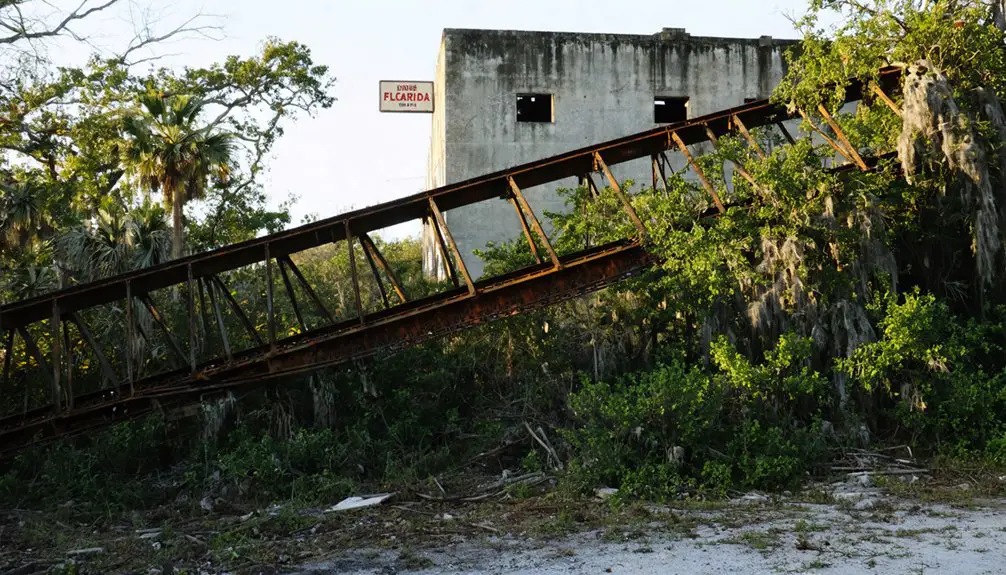
Florida’s phosphate mining industry transformed Brewster from empty land into a bustling company town in 1910. As phosphate extraction techniques advanced, the region’s mining technology quickly established Florida as America’s phosphate powerhouse, producing 79% of the nation’s supply by that year.
You’ll find Brewster’s story mirrors the industry’s dramatic arc. The town thrived in the 1920s as part of the prosperous Bone Valley mining operations, with its processing plants, worker housing, and integrated infrastructure supporting the burgeoning industry.
However, the 1930s brought significant changes as union contracts weakened company towns’ grip on workers. By 1962, modernization and centralization forced Brewster’s closure, with residents relocating to nearby cities.
The final chapter came when environmental concerns led to state ownership of the land through a settlement with American Cyanamid.
Daily Life and Town Amenities
During your time in Brewster, you’d have found a self-contained community equipped with essential services including a doctor’s office, post office, and grocery store.
You could enjoy recreational activities at the town’s swimming pool, recreation center, and movie theater, though these facilities were segregated by race according to the social norms of the period.
Your daily needs would be met by local establishments like the drug store and saloon, while the company-operated utility systems guaranteed reliable power, water, and sewage services.
Social Activities and Recreation
While many company towns offered basic amenities, Brewster stood out for its diverse recreational facilities that enriched residents’ daily lives.
You’d find a swimming pool, recreation center, and movie theater serving as popular spots for community gatherings and recreational events. The town’s saloon, which still bears the Brewster name, acted as a bustling social hub.
The racial segregation of the era shaped social interactions, with white residents living south of the mine and black residents to the east.
Despite this division, you’d see daily social life revolving around shared spaces like the school, grocery store, and post office. The recreation center hosted various activities, while outdoor spaces provided informal meeting spots where neighbors could connect outside of work hours.
Self-Contained Community Services
As a fully self-contained community, Brewster offered residents extensive services that eliminated the need for frequent trips to neighboring towns.
You’d find essential amenities including a post office, grocery store, drug store, gas station, and even a movie theater. The town prioritized community health through its medical clinic and doctor’s office, where workers and their families received both routine care and treatment for mining-related conditions.
For residential education, Brewster maintained its own school system for workers’ children.
The town’s infrastructure included a power plant with a distinctive smokestack, rail connections for phosphate shipping, and a community swimming pool.
While housing areas were segregated by race, all residents had access to these core services until the town’s closure in 1962.
Economic Impact on Polk County
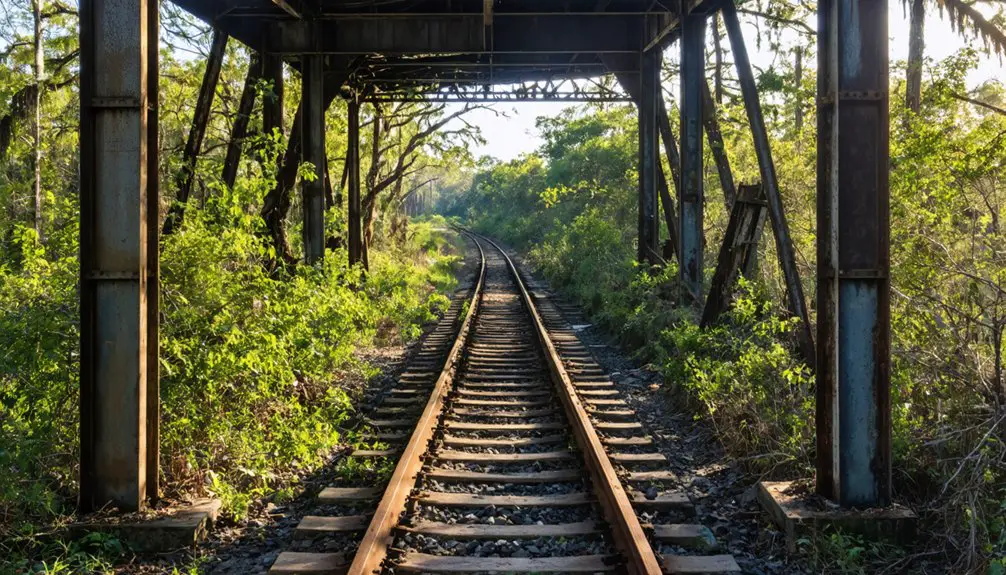
Since its establishment in 1910, Brewster played a pivotal role in Polk County’s economy through its phosphate mining operations under American Cyanamid Company.
As a self-contained company town, it provided extensive employment and infrastructure that supported local economic resilience until the 1960s.
When Brewster closed in 1962, you’d have witnessed significant changes across Polk County. The closure triggered labor migration as residents relocated to Fort Meade, Bartow, and Mulberry.
While some mining jobs shifted to Fort Lonesome, the town’s shutdown created lasting economic ripples. Environmental cleanup costs and legal settlements with American Cyanamid Company impacted county budgets, leading local leaders to pursue economic diversification.
Today, you’ll find Polk County’s economy transformed, focusing on tourism, sports, and aviation rather than solely depending on phosphate mining.
The Final Days and Relocation
Once American Cyanamid Company announced Brewster’s closure in the early 1960s, residents faced life-changing decisions about their future. The company offered them a chance to buy their homes at bargain prices, marking the beginning of a major community migration.
You’d find former Brewster families relocating to nearby towns like Fort Meade, Bradley Junction, Bartow, and Mulberry.
This cultural transformation shifted residents from a tight-knit company town lifestyle to dispersed homeownership across Polk County. The town’s amenities – including the school, grocery store, doctor’s office, swimming pool, and recreation center – gradually shut down.
Remnants and Ruins Today
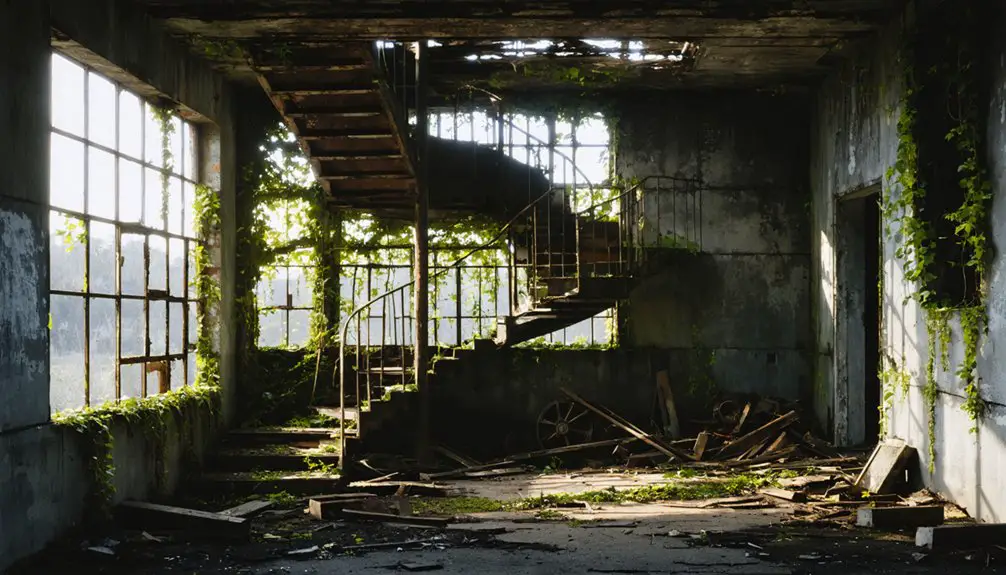
Today’s visitors to Brewster encounter a haunting mix of industrial ruins and nature’s reclamation. You’ll find abandoned gas station buildings with vintage 1970s features standing as silent witnesses to the town’s urban decay.
The phosphate mining operation’s remnants, including drying plants and the company’s main office, dominate the landscape, though many structures have been demolished or fenced off by Mosaic Co.
While most residential buildings were relocated or demolished after the 1960s closure, you can still spot fragments of the town’s historical significance through archaeological remains.
Nature has aggressively claimed its territory, with trees bursting through buildings and ivy consuming walls. The iconic smokestack stands as a resolute reminder of Brewster’s industrial past, while dense vegetation transforms abandoned interiors into wild, indoor jungles.
Preserving Brewster’s History
While Brewster’s physical structures continue to decay, dedicated efforts to preserve the town’s history persist through multiple channels.
You’ll find extensive historical documentation in official records from American Cyanamid and The Mosaic Company, along with collections at local historical societies and university archives.
Community outreach plays a crucial role in keeping Brewster’s legacy alive. The Mulberry Phosphate Museum offers educational programs, while ghost town tours and school curricula share the story of this former mining town.
Digital reconstructions and virtual tours help visualize Brewster’s original layout, though preservation faces ongoing challenges. Limited access to the site, which remains under private ownership, complicates physical preservation efforts.
Despite these obstacles, local historians and former residents continue contributing to exhibitions and commemorative projects that maintain this significant piece of Florida’s industrial heritage.
Frequently Asked Questions
Are There Any Ghost Stories or Paranormal Activities Reported in Brewster?
You won’t find documented ghost sightings or paranormal investigations at this location. Research shows no credible reports of supernatural activity, despite the eerie abandoned buildings and atmospheric ruins that remain.
What Happened to the Cemetery and Burial Grounds After Brewster Closed?
Believe it or not, you’ll find the cemetery standing its ground to this day. Cemetery preservation efforts kept graves intact after Brewster closed, with burial ground legends drawing historical society tours and curious visitors.
Did Any Famous People or Notable Events Originate From Brewster?
You won’t find any famous residents from Brewster, as historical records don’t identify notable individuals. The town’s significance stems from its role as a phosphate mining community rather than celebrity origins.
What Was the Peak Population of Brewster During Its Most Active Years?
Like a bustling beehive at harvest time, you’d have found Brewster’s demographics swelling to roughly 2,000 residents during the mining boom, when the phosphate industry was running at full steam.
Were There Any Major Accidents or Disasters in Brewster’s Mining Operations?
You won’t find major mining hazards or accident reports specific to Brewster’s operations. While Florida’s phosphate industry faced environmental disasters, there’s no documented evidence of serious underground accidents at Brewster’s mines.
References
- http://www.gribblenation.org/2018/09/ghost-town-tuesday-brewster-florida.html
- https://www.ghosttowns.com/states/fl/brewster.html
- https://abandonedfl.com/brewster/
- https://www.youtube.com/watch?v=TJwAIkGtWvU
- https://www.paranormalghostsociety.org/Ghost Town Of Brewster.htm
- https://fipr.floridapoly.edu/about-us/phosphate-primer/company-towns.php
- https://floridatrailblazer.com/2017/07/11/brewster-ghost-town-in-polk-county/
- https://1flminingtown.weebly.com/brewster.html
- https://www.youtube.com/watch?v=o_tOYaC1cz8
- https://mosaicfloridaphosphate.com/life-after-mining-understanding-reclamation-and-release/
